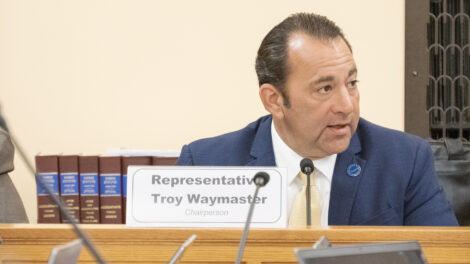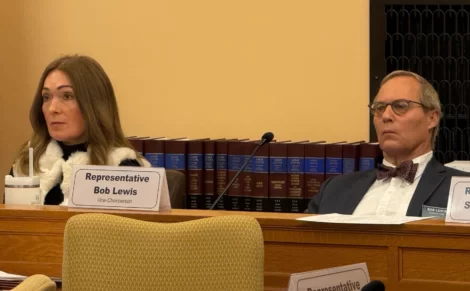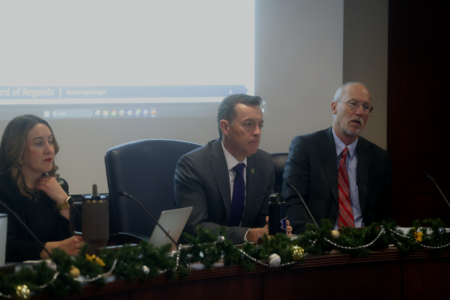College-readiness levels hit new lows in Kansas; state leaders say they have a plan, even if the reasons why aren’t clear
Both college-going and college-readiness rates fell faster than national average

photo by: Adobe Stock
The numbers of the moment have not been kind to universities across the state.
At the University of Kansas, $40 million is the amount of budget pain leaders here worry about if new regulations are placed on how universities can spend federal grants from the National Institutes of Health. At Kansas State, it already has lost federal grants that reportedly were worth at least $35 million, and layoffs of about 10 people — thus far — have come as a result. At Wichita State, grant losses of at least $3.9 million have been reported.
But the numbers of the decade, in some ways, may be even tougher.
While universities can hope for a change in heart from the Trump administration or a court ruling that halts some of the federal changes aimed at higher education, it is less clear what universities can do — or should even make — of a decade’s worth of data that shows Kansas is producing fewer students ready for college, and even fewer still who are much interested in attending any form of higher education.
A review by the Journal-World found that student achievement numbers crossed a new threshold last year. The numbers show that Kansas students hit a new low in terms of college readiness levels. Kansas fell below the national average in every category the standardized testing organization ACT uses to measure a student’s readiness for college. Just 10 years, earlier Kansas was above the national average in every category.
The Journal-World further found that the college-going rate for graduating high school seniors — which includes not just those going to universities, but also to community colleges and technical schools — is falling faster in Kansas than in the nation as a whole. That’s happening even though Kansas has had success in getting larger numbers of high school students to take college classes while still in high school.
K-12 and higher education leaders that the Journal-World reached out to weren’t entirely sure what to make of Kansas’ college-readiness averages declining at a rate greater than that of the nation as a whole.
“There doesn’t seem to be one clear-cut answer,” Blake Flanders, president and CEO of the Kansas Board of Regents, told the Journal-World via email.
Why the percentage of Kansas students choosing to attend some form of higher education after high school is falling faster than the national average also is a question without an easy answer, several of the experts said.
“In my world, I would argue these data need to be explored in more detail to truly understand why the percentages going to college are declining,” Rick Ginsberg, dean of KU’s School of Education, said in an email to the Journal-World. “Costs have gone up, other jobs may be available … You are raising the right questions. These are all issues that need to be explored in more detail.
Flanders said his organization — which oversees the state university system, community colleges and many technical schools — wants to better understand the issue too.
“We’re concerned about the decline in college readiness among Kansas students,” Flanders said. “Earning a postsecondary credential remains the surest path to a job with sustaining wages.”
At the K-12 level, Denise Kahler, spokeswoman for the Kansas State Department of Education — which regulates the state’s public K-12 education system — also said answers aren’t clear cut. She said some students may not be enrolling in college because the technical education programs offered in high school are “way more robust” than they have been in past years. Thus, a larger number of high school students may be getting good jobs right out of high school than was the case earlier this decade.
But the department also is not ignoring the declining college readiness numbers. She pointed to at least four specific initiatives underway that are tied to improving student success in K-12 education. An entirely new way of teaching reading in schools is chief among them. Elementary schools across the state are beginning to teach students in the “science of reading,” which is a different method for teachers to instruct students on how to recognize and form words.
The Kansas Board of Regents is heavily involved in that effort too. In addition to getting its universities ready to teach future teachers how to use the science of reading method, it also is standing up learning centers across the state to help current teachers become certified in the method.

photo by: Chad Lawhorn/Journal-World
Blake Flanders, president and CEO of the Kansas Board of Regents, participates in a board meeting on March 17, 2022.
Flanders thinks literacy issues are surely part of the reason there has been a decline in college readiness levels.
“Literacy rates have declined,” Flanders said. “Since reading is a critical skill to succeed in all areas, a drop in literacy impacts readiness across all subject matters.”
Whatever the cause for Kansas’ decade of decline in the numbers, Kahler said she’s optimistic about the efforts underway to reverse it.
“The amount of work our schools are undertaking right now to improve student literacy and postsecondary readiness is really impressive,” she said.
Here’s a closer look at the numbers pointing to Kansas students being less prepared and less willing to go to college.
College readiness
The ACT organization sets benchmarks for what students should score in various subjects in order to be labeled “college ready.” The organization has found that students who meet the college ready designation have a 50% chance of earning a B or better and a 75% chance of earning a C or better in relevant first-year college courses.
Here’s a look at the percentage of Kansas students in 2014 who met the college ready benchmarks versus the percentage of students nationwide who met the benchmarks:
• English: 72% Kansas; 64% national
• Reading: 51% Kansas; 44% national
• Math: 50% Kansas; 43% national
• Science: 44% Kansas; 37% national
• Meeting all four subjects: 31% Kansas; 26% national
A decade later, here’s where the numbers stood in 2024.
• English: 50% Kansas; 51% national
• Reading: 39% Kansas; 40% national
• Math: 27% Kansas; 29% national
• Science: 29% Kansas; 30% national
• All four: 18% Kansas; 20% national
Readiness levels fell both statewide and nationally during the decade, and in most instances, Kansas is only a couple of percentage points below the national averages. However, the more striking number is how much the gap between Kansas and the nation has changed. In 2014, Kansas was at least five percentage points ahead of the nation in every category and now the state is eight to nine percentage points lower than it was then in multiple categories.
Test takers
Kahler, with the Kansas State Department of Education, offered a possible explanation for Kansas’ performance on the ACT scores: A broader range of students now take the test in Kansas. In 2018, the state began paying for every Kansas junior to take the ACT, if the student chose to do so. Before that, Kahler said it is believed that most of the students taking the ACT “were those students who knew they were going to pursue a college degree.”
Post 2018, the number of students who are taking the ACT with no concrete plans of going to college has perhaps increased, given that there is no cost to take the test. If students with few plans to go to college had been taking the test in significant numbers prior to 2018, Kansas’ college readiness numbers may have looked significantly different back then.
In other words, the numbers may not be indicative of fewer Kansas students being college ready, but rather may be the result of a different mix of students taking the test.
That may be accurate, but it is hard to say so definitively. The ACT does urge people to consider the percentage of students taking the test when making comparisons between years. Indeed, some states in the region over the past decade have seen their scores fall as the percentage of students taking the test has increased. That includes Arkansas, Nebraska and Oklahoma. But there’s also evidence that the percentage of students taking the test isn’t the sole determinant in falling test scores, as Iowa and Missouri both have smaller percentages of students taking the test, but also have seen test scores decline during the decade.
What is clear is that the gap between the percentage of Kansas students who take the ACT and the percentage of Kansas seniors who go to college has changed significantly during the decade. In 2014, the percentage of Kansas students taking the test was about 74%, while the percentage of graduating seniors who continued their education was about 68% — a gap of about 6 percentage points. In 2024, the number of students taking the ACT is estimated to be about 78%, using data from the state department of education. The college-going rate, however, has fallen to about 58% — a gap of about 20 percentage points.
College going
The change in that gap from 2014 to 2024 might explain why Kansas’ college readiness levels have declined. But that explanation also runs the risk of missing a bigger point: The college-going rate of Kansas high school students is really declining.
The college-going rate — as measured by high school graduates who go to either a university, community college or technical school the year following their high school graduation — has dropped 10 percentage points since 2014. Nationally, the college-going rate has dropped 7 percentage points during the same time period.
That drop has occurred even though Kansas has become aggressive in trying to get high school students to enroll for college courses while they are still in high school. Kahler quoted Kansas Board of Regents statistics that showed about 29,500 high school students in 2017 were taking college courses. By 2024 that number had grown more than 25% to about 38,000 students.
Higher education leaders have promoted those early classes as a way to lower the cost of education, as many of those courses cost less during high school, and getting started while you are a high school junior or senior should shorten the number of years a student must physically attend a university or college.
But the early start in college classes is not leading to a greater percentage of Kansas students actually attending college after high school. It may be that the classes are primarily serving students who already had planned to go to college, but are not convincing many undecided students of the value of doing so.
Regardless, Kahler said the numbers do speak to a positive, as the statistics show high school students aren’t just enrolling in the classes but that students also are passing the classes.
“This tells us that students can do the work,” she said.
Indeed, not all the numbers related to Kansas students and their path to college have been negative. Flanders, at the Kansas Board of Regents, said state universities are seeing numbers that show them performing better than what you would expect given the declining college readiness scores from the ACT.
For example, in the latest statistics from KU, the percentage of freshmen who return for their sophomore year hit a new high of 86.5%. That’s up from 80% in 2014. The percentage of students who graduate within four years also is up during the time period by an even greater percentage. The most recent mark stands at 55.8%, up nearly 10 percentage points from 2014.
Given that standardized testing scores are showing students are less college ready, you wouldn’t necessarily expect those retention and graduation numbers to have improved, Flanders said.
“Our college outcomes suggest that universities are doing far better than ACT college readiness benchmarks might predict,” Flanders said.
The reason, he said, is that the university system has recognized the need, even if it can’t fully explain the cause for incoming students being less college ready. The university system — with KU being one of the early adopters — has been using a system often called “student success playbooks,” which place an emphasis on the importance of academic advising, clear pathways for students to transfer credits from community colleges, and new strategies on the types of math classes that certain degrees are required to complete.
The strategies that are being implemented have been expensive, as KU has spent millions reorganizing its academic advising system, among other student success initiatives. But the results give Flanders optimism that the state’s universities and colleges can find ways to help students, even if the scores say they may not be ready for the next chapter of their education.
“We can continue to help students achieve their full potential even in the face of falling preparedness rates, but it will require a continued commitment to data-driven, proven approaches and strong partnership with policymakers,” Flanders said.







